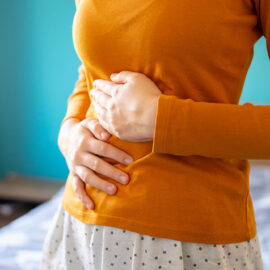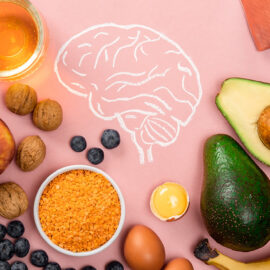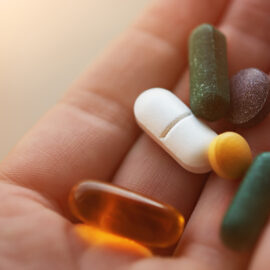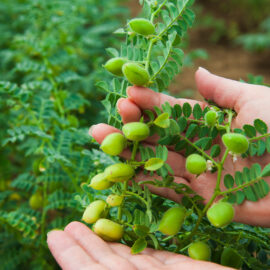Food production puts tremendous pressure on the health of our planet. The estimated worldwide population of 9 billion by 2050 will test the sustainability and resilience of the food system. Food systems cover the gamut of production and processing of food, consumption practices, nutrition security and population health. Farming and retail practices, marketing of food and consumer demand can impact the types of food available.1 Earth Day is a great time to learn ways to invest in our planet with sustainable food practices.
Since the early days of the pandemic in 2020, we’ve seen firsthand how easy it is to experience disruption in the delicate balance of food supply and demand. Supply chain slowdowns, a shortage of workers, transportation issues and sudden closures of businesses and institutions led to a massive waste of food. Meanwhile, consumers flocked to grocery stores to stockpile food. Despite this, being at home led people to put more thought, planning and time into meals which lead to less overall household food waste.2 This experience provided some insight into sustainable practices for the future of food that benefit both diet quality and the environment.
There is enough food produced worldwide to supply over 2,750 calories per person every day.3 While this ensures that adequate food is available, the current supply of food does not help people meet recommended amounts of produce and plant-based sources of protein.3,4,5 The Harvard Healthy Eating Plate and the 2020-2025 Dietary Guidelines for Americans recommend half of the plate be fruits and vegetables and one quarter of the plate include protein. Both guidelines recommend limits on red meat and processed meat such as bacon and sausage.4,5
Besides the health benefits of fruits and vegetables and plant-based proteins, focusing on growing more of them would use less arable land (for growing crops), save pastureland and reduce greenhouse gas (GHG) emissions.3 Certain GHG emissions in farming, including nitrous oxide and methane, are linked to global warming.6 Ultimately, droughts, extreme weather and storms as a result of climate changes pose challenges for agriculture and continued food production.1
Trading animal for plant-based proteins can be beneficial for health and the environment.7 About 30% of the loss of biodiversity and 14.5% of GHG are due to animal farming.8 Biodiversity is important as it integrates ecological and sociocultural factors, ensures continued diversity of the diet, and it is essential for continued food security.9
Plant-based foods including legumes such as pea protein can provide twenty times as much nutritionally similar food per section of cropland as beef, and replacing all animal-based foods with plant-based alternative foods could feed 350 million additional people.7 This is not to suggest that a vegan diet is the answer for everyone, but a 25% reduction in meat consumption in high income areas of the world would minimize the environmental impact of farming land expansion on biodiversity, ecosystems and carbon dioxide emissions.10
Food is discarded throughout the food system. About 30% of edible food produced is wasted.11 When food is not used, the resources used to produce the food including water, soil erosion and depletion, transportation, etc. are lost, while the damage to the environment from GHG remains.9
Discarded food is the most common item found in landfills.12 Tossing uneaten or spoiled food accounts for 15% of trash in the US, and this does not even account for scraps sent down the garbage disposal. Unappealing “ugly” produce is healthful but is viewed by people as poor quality and is often wasted. Consumers can make a difference in reducing personal food waste by choosing “ugly” produce, eating what they buy, composting inedible food scraps and using shelf-stable frozen, dried, and canned items as well since they are less likely to be tossed.11
Despite having adequate food to feed the world, food systems must work harder to manage resources appropriately, avoid waste and reduce their impact on the environment to be sustainable and improve nutrition and food security.13 Innovations in this cycle include looking at data from agriculture, the supply chain, food processing and retail habits to find ways to optimize production, consumption, and security of all food products.14 The food industry has the resources to transition to a more sustainable food supply and to provide food to those most in need.15 Some of the actions that can be taken include:
- Reduce water and energy use and manage waste.
- Develop sustainable food delivery systems and responsible food packaging.
- Engage consumers in ways they can practice sustainability through purchase of food and reducing food waste.
- Recognize the importance of producing nutrient-dense foods such as dairy, fruit and whole grains, despite environmental strain, since these foods are valuable for nutrition security.15,16
- Food systems should work to be transparent and provide unbiased information about the food production process and communicate with consumers about the sustainable practices used to produce food.13,15
Precision agriculture advancements currently underway include examining farming habits to optimize treatment of crops, animals and land and improve the work environment for agricultural workers. Smart farming technology concentrates on examining farming habits to streamline these aspects for efficient and timely production of food.14
People often have a negative association with the words “processed food.” Most food brought to market is processed in some fashion, and certain processing methods serve to protect and prolong the food supply. The shelf life of canned, frozen, and dried foods allows nutrient-dense foods such as fruits, vegetables, and legumes to be accessible, and their use should be encouraged regardless of income status. These foods are also linked to less food waste.11,15
Biodegradable and sustainable food packaging helps reduce the environmental impact of plastic packaging, which often ends up in landfills, poses harm to aquatic life and has been linked to health risks.17 Storing food properly can extend the shelf life of food to help ensure that it gets eaten. Certain types of biodegradable packaging protect and enhance the shelf life of food, and some are made from agricultural waste and renewable feedstocks. Currently, they replace only about 1% of plastics and these products can be costly, yet this packaging is a promising innovation.17
A few companies are well on the way to making advances in food packaging. PouchEco makes compostable food pouches and Ecologic Brands makes recyclable bottles from recycled paper and plastic. Smart grocery shopping apps such as ShopWell can help consumers plan meals and avoid food waste. With nutritional guidance from healthcare professionals they can also steer consumers to healthier foods, suggest food amounts on grocery lists to reduce food waste and provide meals and recipes to help ensure improvements in diet quality.11,18,19
When recycling, be sure to check your local guidelines for the type of items that are accepted. Remove food from containers and check guidelines on rinsing/cleaning food containers prior to recycling. Wishcycling, putting items into the recycle bin that you think might be eligible but are not, causes extra labor to remove these items while those that get pushed through can cause damage to equipment.20
Orgain’s Commitment to Planetary Health
Orgain has a steadfast commitment to a range of environmently friendly practices, including using high-quality planet-friendly ingredients, many of which are USDA certified organic, and by using less plastic in our product packaging. We offer a wide range of plant-based products, and for our dairy-based products, we sources grass-fed milk protein from New Zealand where cows are raised under strict animal welfare regulations set forth by the government of New Zealand that are equivalent to, if not more stringent than regulations set forth by the National Organic Program administered by the FDA.
We also recognized the detrimental impact of plastic use on the environment and took action with sustainability initiatives. Considering single-use plastic straws are among the top 10 contributors to plastic marine debris across the globe and are too lightweight to make it through the recycling sorter – if they get recycled at all – Orgain removed plastic single-use straws from its Kids Protein™ Nutrition Shakes and instead, transitioned to Tetra Pak® packaging with biobased caps. This transition will remove 8 million plastic straws from our supply chain annually.
In addition, Orgain’s Green Initiative, launched in 2020, has significantly reduced the amount of plastic in our containers, while still providing the same amount of product. This change saves 30,000 pounds of plastic and will save more than 4,900 trees annually.
Orgain also provides ongoing educational opportunities on topics related to environmental health and nutrition. Our professional education webinars include topics such as Eating Like the World Depends On It (Because It Does…), presented by Dr. David Katz, and on The Good Clean Nutrition Podcast, we feature guests such as Kate Geagan, MS, RD who chats with host. Mary Purdy MS, RD about Food, Health and Sustainability.
![]()
1 Drewnowski A; Ecosystem Inception Team. The Chicago Consensus on Sustainable Food Systems Science. Front Nutr. 2018 Apr 25;4:74. doi: 10.3389/fnut.2017.00074. PMID: 29744333; PMCID: PMC5930345.
2 Babbitt CW, Babbitt GA, Oehman JM. Behavioral impacts on residential food provisioning, use, and waste during the COVID-19 pandemic. Sustain Prod Consum. 2021 Oct;28:315-325. doi: 10.1016/j.spc.2021.04.012. Epub 2021 Apr 10. PMID: 34722846; PMCID: PMC8536943.
3 Kc KB, Dias GM, Veeramani A, et al. When too much isn’t enough: Does current food production meet global nutritional needs? PLoS One. 2018;13(10): e0205683. Published 2018 Oct 23. doi:10.1371/journal.pone.0205683
4 Harvard T.H. Chan School of Public Health. Healthy Eating Plate. Available at: https://www.hsph.harvard.edu/nutritionsource/healthy-eating-plate/, accessed 3/9/2022.
5 U.S. Department of Agriculture and U.S. Department of Health and Human Services. Dietary Guidelines for Americans, 2020-2025. 9th Edition.
6 Xu C, Han X, Bol R, Smith P, Wu W, Meng F. Impacts of natural factors and farming practices on greenhouse gas emissions in the North China Plain: A meta-analysis. Ecol Evol. 2017;7(17):6702-6715. Published 2017 Jul 21. doi:10.1002/ece3.3211
7 Shepon A, Eshel G, Noor E, Milo R. The opportunity cost of animal-based diets exceeds all food losses. Proc Natl Acad Sci U S A. 2018 Apr 10;115(15):3804-3809. doi: 10.1073/pnas.1713820115. Epub 2018 Mar 26. PMID: 29581251; PMCID: PMC5899434.
8 Stoll-Kleemann, Susanne & Schmidt, Uta. (2017). Reducing meat consumption in developed and transition countries to counter climate change and biodiversity loss: A review of influence factors. Regional Environmental Change. 17. 10.1007/s10113-016-1057-5.
9 Vogliano, C., Geagan, K., Chou, S., Palmer, S. (2021). Empowering Nutrition Professionals to Advance Sustainable Food Systems [White Paper]. Food and Planet.
www.foodandplanet.org
10 Stefan Wirsenius, Christian Azar, Göran Berndes. How much land is needed for global food production under scenarios of dietary changes and livestock productivity increases in 2030? Agricultural Systems. Volume 103, Issue 9, 2010, Pages 621-638, ISSN 0308-521X, https://doi.org/10.1016/j.agsy.2010.07.005.
11 National Academies of Sciences, Engineering, and Medicine; Health and Medicine Division; Division of Behavioral and Social Sciences and Education; Food and Nutrition Board; Board on Environmental Change and Society; Committee on a Systems Approach to Reducing Consumer Food Waste. A National Strategy to Reduce Food Waste at the Consumer Level. Oria M, Schneeman BO, editors. Washington (DC): National Academies Press (US); 2020 Aug 21. PMID: 33211448.
12 United States Environmental Protection Agency. Preventing Food Waste at Home. Available at: https://www.epa.gov/recycle/preventing-wasted-food-home#ways, accessed 3/11/2022.
13 Knorr D, Augustin MA, Tiwari B. Advancing the Role of Food Processing for Improved Integration in Sustainable Food Chains. Front Nutr. 2020;7:34. Published 2020 Apr 3. doi:10.3389/fnut.2020.00034
14 Krupitzer C, Stein A. Food Informatics-Review of the Current State-of-the-Art, Revised Definition, and Classification into the Research Landscape. Foods. 2021;10(11):2889. Published 2021 Nov 22. doi:10.3390/foods10112889
15 Miller KB, Eckberg JO, Decker EA, Marinangeli CPF. Role of Food Industry in Promoting Healthy and Sustainable Diets. Nutrients. 2021;13(8):2740. Published 2021 Aug 10. doi:10.3390/nu13082740
16 Drewnowski A, Fulgoni VL 3rd. New Nutrient Rich Food Nutrient Density Models That Include Nutrients and MyPlate Food Groups. Front Nutr. 2020;7:107. Published 2020 Jul 21. doi:10.3389/fnut.2020.00107
17 Shaikh S, Yaqoob M, Aggarwal P. An overview of biodegradable packaging in food industry. Curr Res Food Sci. 2021;4:503-520. Published 2021 Jul 30. doi:10.1016/j.crfs.2021.07.005
18 Vadiveloo M, Guan X, Parker HW, et al. Effect of Personalized Incentives on Dietary Quality of Groceries Purchased: A Randomized Crossover Trial. JAMA Netw Open. 2021;4(2):e2030921. Published 2021 Feb 1. doi:10.1001/jamanetworkopen.2020.30921
19 Reader’s Digest. 10 Must-Have Apps That Will Revolutionize Your Grocery Shopping. Available at: https://www.rd.com/list/grocery-shopping-apps/, accessed 3/11/2022
20 The Washington Post. Do you wishcycle? If so, you’re not actually helping to recycle. Available at: https://www.washingtonpost.com/health/what-is-wishcycling/2022/01/21/82fe0486-792d-11ec-bf97-6eac6f77fba2_story.html, accessed 3/12/2022

Healthcare professionals are vital partners in the advancement of environmental health and can make a positive impact by providing much-needed education to their patients and clients on ways to support the planet. This month we’re excited to share resources and information to help empower you to incorporate eco-friendly recommendations into counseling.
Food + Planet
This month’s podcast guest, Kate Geagan, MS, RD, is a Co-Founder of Food + Planet, an organization sharing educational resources to empower healthcare professionals to support sustainable food systems and be leaders in sustainable nutrition education.
According to Kate, “Healthcare professionals can play a leading role in providing sustainable diet guidance in ways that easily fit their clients’ health goals, cultural food preferences and budget. Sharing specific local resources can help empower patients or clients to support a more resilient, sustainable food system -such as In Season produce guides, local Community Supported Agriculture (CSA) or farmers market information (including those aligned with the Supplemental Nutrition Assistance Program (SNAP), or spotlighting community-let brands or companies who are generating solutions from within the community. And showcasing “hero” sustainability ingredients in programs such as culinary demos, tastings, recipes, blogs or social media posts can bring this to life for your community in ways that feel right to your authentic voice. For example, this could be more biodiverse or traditional foods, underutilized or heirloom species, or even edible portions of ingredients that can often be cast off as food waste (i.e. beet leaves, broccoli stems or carrot top greens).”
Get started by visiting foodandplanet.org/downloads now and downloading the guide, Empowering Nutrition Professionals to Advance Sustainable Food Systems.
Intersection of Human and Planetary Health
Check out the article below from Food & Nutrition magazine, featuring quotes from integrative dietitian and host of The Good Clean Nutrition Podcast, Mary Purdy, MS, RDN.
Tips for Healthcare Professionals to Share with Patients
The United Nations 2030 Sustainable Development Goals set a Decade of Action guideline for urgent solutions for health, the climate, energy, and natural resources.1 The health of the planet depends on support from healthcare professionals to spread the word about ways transform our food use. It’s critical to listen to patients’ values and beliefs about food and integrate culturally sensitive, meaningful food options. Healthcare professionals are well-positioned to provide solutions to protect and maintain the food supply with these tips:
- Cook more meals at home to help reduce food waste and increase consumption of healthful foods. Consider using an app for shopping and meal planning. When eating out, plan meals accordingly to use food at home before it perishes.
- Buy what you need, use what you buy, and participate in home-based composting of inedible food scraps. Reiterate that composting is not the first step to manage food waste, buying responsibly is the best way to help the planet.
- Keep food fresh for as long as possible. Wait to wash berries until they are served since moisture shortens their shelf life, use air-tight containers for opened packages of food and store food properly in the refrigerator, e.g., don’t store dairy on the refrigerator door as it can be warmer, and keep vegetables in the crisper drawer.
- Try to reduce meat consumption by 25 percent. For example, for those averaging 8 meat-based meals per week, swap in at least 2 plant-based meals.
- When possible, choose eco-friendly packaging, recycle food packaging, remove leftover food prior to recycling and know what items are eligible for recycling.
- Promote the healthfulness of “ugly” or imperfect produce.
- Encourage use of frozen, dried and canned food items as they have a longer shelf life and are linked to less waste. Provide simple, tasty recipes for using these items to capture consumer interest.
- Clear your shelves regularly and donate unopened, unexpired food items to your food bank.
1 United Nations Sustainable Development Goals. Decade of Action. Available at: https://www.un.org/sustainabledevelopment/decade-of-action/#:~:text=2020%20needs%20to%20usher%20in,and%20closing%20the%20finance%20gap. Accessed 3/10/2022
Listen to new episodes of The Good Clean Nutrition Podcast, now available on the Orgain Healthcare app, and be sure to subscribe now on Apple Podcasts, Spotify or anywhere you listen to podcasts so you never miss a new episode!
Episode 12: Nutrition Crossroads: Food, Health and Sustainability with Kate Geagan, MS, RD

Human health is dependent upon the health of the planet, so protecting the planet is of utmost importance. Tune in to learn from sustainability expert and registered dietitian, Kate Geagan, MS, RD, on how the climate crisis has impacted the nutritional quality of food, the importance of biodiversity, and the state of today’s food and agricultural system. Kate also shares practical strategies on ways for you to help create a better food future and educate your patients or clients to do the same.
Kate Geagan, MS, RD is an award-winning registered dietitian and sustainable food expert working at the intersection of food, health, and sustainability. She earned a BA from Middlebury College and went on to earn a MS from Simmons University. She is the co-founder of Food and Planet, an organization dedicated to reaching healthcare professionals to drive the adoption of sustainable diet patterns, and is also the author of Go Green, Get Lean: Trim Your Waistline with the Ultimate Low-Carbon Footprint Diet.
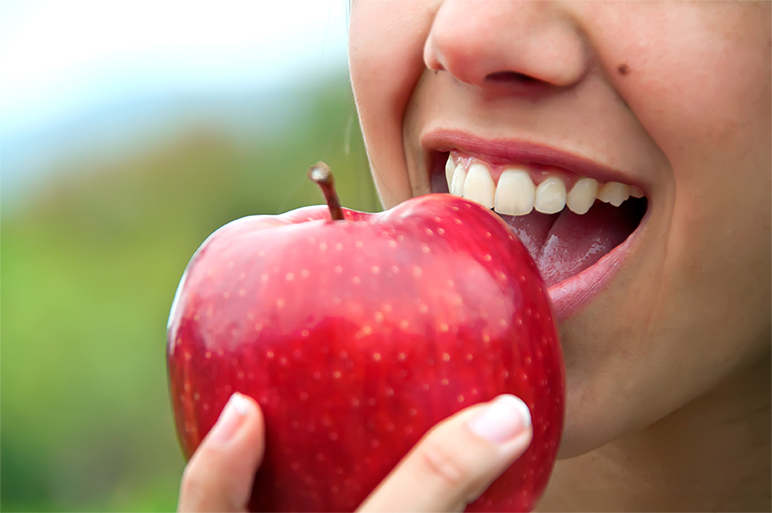
Don’t miss Orgain’s next live webinar on April 21, 2022, at 2pm EST, Open Wide: Optimizing Oral Health Through Diet, presented by Sara Karlin, DDS and Ellen Karlin MMSc, RDN, LDN, FADA. This webinar topic is especially important to share about during Earth month since environmental health and factors, such as climate change, contribute to changes in oral health. Tune in to get a deeper understanding of how diet affects every aspect of oral health and learn about the growing body of research supporting the key role of nutrient-dense foods and beverages that help to cultivate and optimize healthy soft and hard tissues within the oral cavity. Whether on-demand or live, all the webinars in Orgain’s Professional Education Webinar Series is available for 1.0 CPEU for RDNs and NDTRs. Register Here
Have you downloaded the Orgain Healthcare App yet? Available in the App Store and Google Play, our app provides easy access to Orgain Healthcare’s library of on-demand webinars – each offering one continuing education credit for RDNs and NDTRs.
